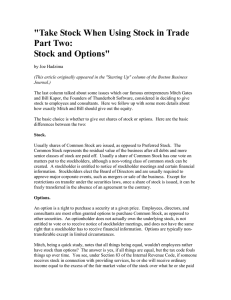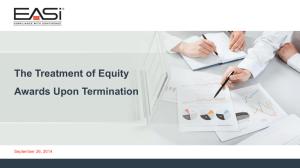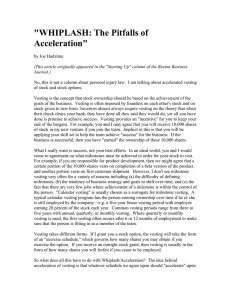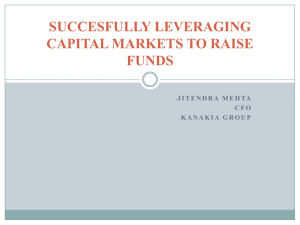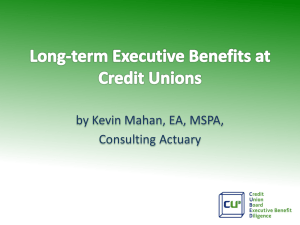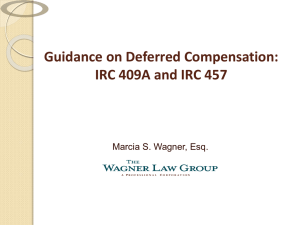to presenter slide deck
advertisement
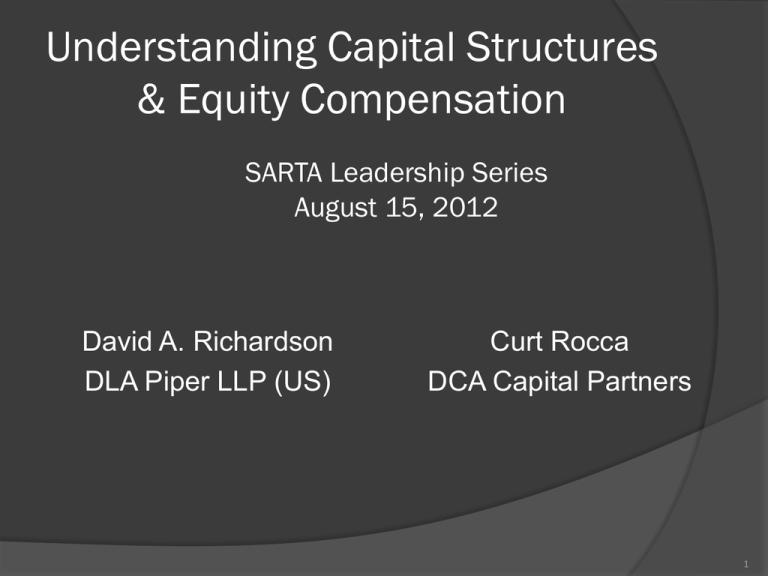
Understanding Capital Structures & Equity Compensation SARTA Leadership Series August 15, 2012 David A. Richardson DLA Piper LLP (US) Curt Rocca DCA Capital Partners 1 Overview Making your company more attractive to investors Capitalizing your business to ensure alignment of interests Structuring an investor friendly cap table from Day One Eliminating obstacles to successful fundraising and exits Creating employee incentives without giving away the company Update on 2012 JOBS Act 2 Making your company more attractive to investors Get your house in order Get your cap table in order 3 Get your house in order Form (the right) entity Organize your minute book and stock book Evict the skeletons Establish strong governance standards 4 Form (the right) entity • If you haven’t formed an entity, form one • • • • • Establishes credibility Limits liability Houses IP Establishes currency If you have formed an entity, make sure it’s in order • Complete organizational steps • Consider converting (LLC to C-corp) 5 Form (the right) entity • Types of Entities: • • • • Partnership Limited Liability Company (LLC) S Corporation C Corporation 6 Form (the right) entity VCs like Delaware C-corps: Relatively cheap Well-established laws (statutes and case law) Limited liability VC familiarity and better for fundraising No pass-through of profits and losses VC investment restrictions Double taxation – who cares? 7 Capitalizing your business to ensure alignment of interests Authorized shares (people like “000s”) Actually purchase shares (cash and non-cash contributions) Founder share split Debt, Preferred Stock and Common Equity Investor views of founder ownership/incentives 8 Structuring an investor friendly cap table from Day One Anticipate dilution over time Vesting and Section 83(b) Dealing with “dead equity” Maintain detailed stock ledger and organized files Who’s your Paul Ceglia? 9 Sources of Funding • • • • • • • • • • • Existing investors Friends and family Angels Venture capital Private equity Strategic Commercial loan SBA loans SBIR grants Private loan IPO 10 Don’t ignore securities laws Federal exemptions and safe harbors California state exemptions Generally, stick to “accredited” investors How is the JOBS Act changing this? (more on this later….) 11 Creating employee incentives without giving away the company • • • • • • • • Employee incentives – understanding your options Who to incentivize Pros and cons of target and broad-based plans Vesting terms Performance based? To accelerate or not to accelerate? Make sure incentives are aligned How large a pool? 12 Equity is not candy • Options, warrants, restricted stock are important “currency” for start-ups low on cash, but . . . • Mind your cap table • Equity grants need to comply with securities and tax laws • Vesting • Helps create incentive • Helps avoid “dead equity” 13 Who to incentivize • Early stages • Key employees • Key advisors and consultants • Later stages • Managers • Rank and file • Independent directors • Adopt a compensation matrix 14 Types of Awards • Equity – Stock Options • Incentive Stock Options (ISOs) • Nonstatutory Stock Options (NSOs) – Restricted Stock – RSUs (public companies) – Phantom Stock • Cash – Performance bonuses – Change of Control bonuses – Management bonus/carve-out plans 15 Types of Awards Incentive Stock Options (ISOs): Can be granted only to employees May provide tax advantages to employees Must comply with Tax Code provisions 16 Types of Awards ISO Requirements Eligibility - May grant only to employees of company or parent/subsidiary of company. Exercise Price - May not be less than FMV on grant date (110% of FMV for 10% shareholders). Option term - Cannot exceed 10 years (5 years for 10% shareholders). Post-termination exercise – ISO treatment lost if not exercised within 3 months of employment termination (max 1 year if due to disability; no limit other than option term in case of death). 17 Types of Awards Nonstatutory Stock Options (NSOs): Can be granted to employees, consultants and outside directors No special statutory requirements, but exercise price must be at least grant date FMV 18 Income Tax Treatment of Options NSO ISO No income No income Ordinary Income Exercise spread None AMT adjustment None Exercise spread Grant Exercise ISO Holding Period Met? Sale Yes No (Disqualifying Disposition) Ordinary income Capital gain None None Exercise spread Post-exercise gain Exercise spread & post-exercise gain Post-exercise gain (Assumes all shares vested on exercise.) 19 IRC 409A Adopted by Congress in 2005, enacted in 2008 Clamps down on service providers choosing when they’ll have taxable income Thank you, Enron and Broadcom 20 IRC 409A Requires service provider to include in gross income “deferred compensation” under “nonqualified deferred compensation plans” Deferred comp arises when a service provider acquires a legally binding right (even if contingent) to compensation that is or may be payable in a later taxable year (e.g., stock options) 21 IRC 409A Penalties for noncompliance: Taxation in year of vesting, even if no payment received Additional 20% penalty tax at federal level Additional 20% penalty tax at California level Ordinary income tax on the spread ○ In California, total tax equates to roughly 80% Company has withholding obligation Tax liability for not withholding appropriate amounts at each vesting milestone 22 IRC 409A Options: no “deferred income” if granted at FMV What is FMV for 409A purposes? Private company: “Value determined by the reasonable application of a reasonable valuation method.” Three “safe-harbors”: third party appraisal internal report for start-ups repurchase formula under Section 83 23 IRC 409A Best practices for private companies: Earliest stages (before outside investment): ○ Grant or sell restricted stock (exempt from 409A) After outside investment, use safe-harbor method: ○ Independent appraisal ○ Written report by qualified individual 24 Vesting • “Standard” vesting: – Employees: 4-year vesting (1/4 on one-year cliff; 1/48 per month thereafter) – Directors and key advisors: 2-3 year vesting (monthly) – Careful – vesting terms should match shortterm AND long-term goals • Be thoughtful about tying vesting to performance (as opposed to timebased) metrics 25 Vesting To accelerate or not to accelerate: Single- and double-trigger acceleration on change of control Acceleration on termination of service May be hindrance to exit Don’t be surprised by “reverse vesting” 26 Don’t ignore securities laws Federal exemption for options under Rule 701 California state exemption under CCC Section 25102(o) and Cal. Regs. 27 Update on 2012 JOBS Act • • “Things are happening!” Four major components: 1. 2. 3. 4. General Solicitation IPO on-ramp Crowdfunding 2,000 Shareholder Rule • SEC missed first rulemaking deadline (revisions to Reg. D Rule 506 to permit general solicitations to accredited investors) • No revised deadline. 28 General Solicitation • Historically companies looking to raise capital cannot run advertisements or solicit investment from persons with whom they have no pre-existing relationship • Revised rules will allow broader-based solicitations of persons with whom no preexisting relationship exists • Other securities rules apply • Rules are still not finalized, so be careful… 29 IPO On-Ramp Effective immediately on April 5, without any SEC rulemaking Emerging growth companies may initiate the IPO process by confidentially filing preliminary registration documents, go public with two years of audited financials instead of three, and receive analyst coverage immediately after going public. Phase in full public reporting and internal controls over five years “Emerging growth company” = (i) a domestic or a foreign private issuer with total annual gross revenues of less than $1 billion during its most recently completed fiscal year and (ii) prices its IPO on or after Dec. 9, 2011 Evidence suggests that most companies are choosing the confidential route 30 Crowdfunding 270-day rulemaking period (i.e., no crowdfunding until 2013) “Rules” expected this year, but SEC has been explicit in its general concerns about crowdfunding Expecting crowdfunding to be severely limited 31 2,000 Shareholder Rule Effective immediately on April 5, without any SEC rulemaking Alleviates the “500 shareholder rule” threshold for registration and public reporting (was a major concern for FB) 32 33 How to reach us • David Richardson – david.richardson@dlapiper.com – (916) 930-3256 • Curt Rocca – crocca@dcapartners.com – (916) 960-5353 34

